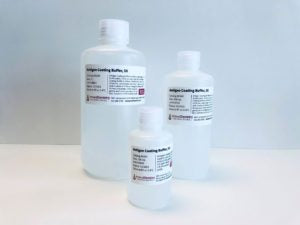Question: What is your advice for preparing stable dried ELISA plates?
Answer: In our experience we have generally found dried coated/blocked antigen plates to be more robust than dried coated/blocked antibody plates, although depending on the nature of the protein, both can last for years stored properly. It is critical that a blocker component be included for long-term stability of ELISA plates in dried form.
ICT’s Antigen Coating Buffer maximizes the adsorption of antigens onto polystyrene plates and stabilizes their structure to enhance specific signal, save reagents, and extend the shelf life of coated plates. Stabilizing the coated antigen allows for better analyte detection and enhances the specific signal of the assay. By generating a higher positive signal, a lower concentration of coating antigen may be used, saving valuable reagents.
Under proper storage conditions, coated plates may last for years, enabling the manufacture of large batches for inclusion in diagnostic test kits. This also proves useful in non-manufacturing settings, where large batches of plates may be prepared at once to be stored for future experiments.
Here’s our advice for preparing stable dried ELISA plates:
- We recommend coating overnight at RT or 2-8°C, protected from light, covered in a humidified container to minimize evaporation of the coating solution from the plate wells. Coating equilibration probably occurs sometime around 8 hours plate exposure time. In our experience, and for practical workflow this usually would entail coating plates in early afternoon and washing and blocking the next morning. For a covered humidified container, you can use something as simple as a Rubbermaid container containing moist paper towels. The plates are stacked so they don’t have to be individually covered and the top plate is empty/un-coated and just used as a cover.
- After coating, we recommend washing the wells 2X with ELISA Wash Buffer before adding the plate blocker to the wells.
- The blocker should be added immediately after the 2X plate wash steps. Always add at least 300 µL of blocker per ELISA plate well. Adding less can greatly contribute to well-well signal output variability.
- We recommend once again blocking overnight at RT or 2-8°C. Shorter plate blocking periods don’t allow enough blocker absorbance time to saturate the plate well surface with blocker component. As with coating, carry out the blocking step, protected from light, covered in a humidified container.
- After blocking, the plates are normally dumped in the sink or waste container, turned upside down and pounded on paper towels to remove excess liquid, and placed in a vacuum plate dryer for 4 hours at RT. If you don’t have a vacuum dryer, you can just place them face up in a laminar flow hood where air can pass over the plate surfaces allowing them to dry passively. If that isn’t available, they can be placed on a lab bench in a dark corner of the lab where they can remain undisturbed for several hours until completely dry. In the drier months, when the humidity is lower, plates can generally be considered dry after a 4 hour period in the vacuum environment or a 6 hour time frame in a moving air type hood or other drying apparatus. Do not use any heat drying methods as it will denature the coated protein.
- Once dried, we recommend packing plates individually in foil bags. Included in each foil bag, we use a 5 g desiccant pack to further enhance stability of the coated protein. We put the desiccant packet directly on top of the ELISA plate before sealing the foil bag with a heat sealer.
- Coated and blocked plates should always be stored at 2-8°C for long term storage.


